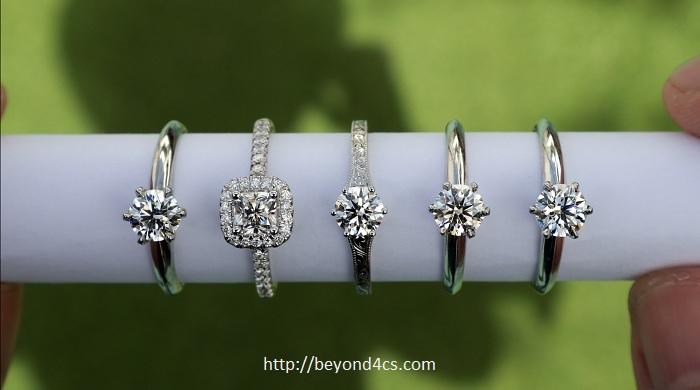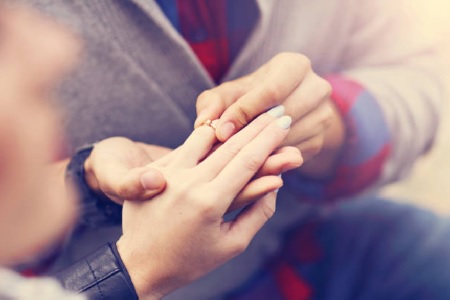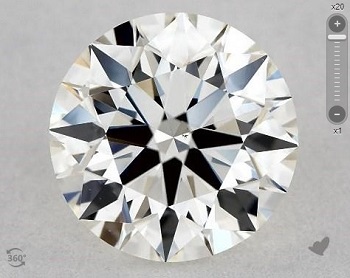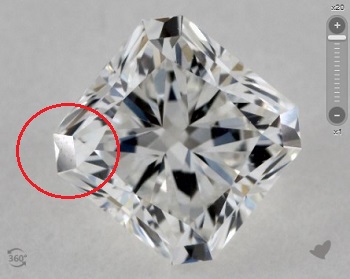Colorless Diamonds vs Near Colorless Diamonds (With Video)

Side by side comparison of colorless vs near colorless diamond rings. Can you see differences?
When it comes to buying diamonds, color is one of the misunderstood attributes of the 4Cs.
In fact, I often get questions like, “Is a H color diamond too yellow?”, “Can I see differences between a D and F color diamond?”, “Is an I color good enough for an engagement ring?” and the list goes on.
So, if you are shopping for a diamond ring and you aren’t sure about the visual differences between different color grades, you’ve come to the right place.
In this write up, we will take an indepth look at 2 of the most popular categories of diamonds; the colorless and near colorless range.
We also performed a detailed video comparison between colorless vs near colorless diamond rings in common everyday environments. If you want to see exactly how the different diamond colors look like in real life, be sure to check it out.
First of All, What Are Colorless Diamonds?

The GIA grading scale showing the entire range of D-Z diamond colors.
On the GIA grading scale, the color grades of D, E and F are described as colorless and they exhibit an absence of color. Here, I want to emphasize that diamonds are graded face down and examined through their side profiles in a controlled lighting environment.
In real life conditions, it would be extremely difficult for the average lay person to see color differences between a D, E and F diamond once it is mounted on a setting. Once you watch the video comparison below, you will probably come to the same conclusion as well.
I also want to address a common misconception that a colorless diamond will appear more brilliant and sparkly. The truth is far from that. Color has nothing to do with a diamond’s performance and it is cut quality that actually matters the most.
Next, What Are Near Colorless Diamonds?
Price comparison between 1 carat diamonds: D colorless ($8,930) vs I near-colorless ($6,610).
Near colorless diamonds are comprised of the following grades: G, H, I, and J. These diamonds contain very small traces of color and are quite difficult to detect with the naked eye.
Speaking from experience, I and J colors are the most common thresholds before people notice a tint of warmth in the diamonds.
In my opinion, near colorless diamonds like the G or H colors offer the best value for money as they can face up white and do not have a price premium attached to them.
Video Comparison of Colorless vs Near Colorless Diamonds in Real Life
For the majority of consumers, the most important question when it comes to color is, how colorless should your diamond be? Do you really need a D color in order for your eyes to perceive the diamond as icy white?
Watch this full length video and you should be able to find answers on your personal threshold for color.
FYI, most of the rings seen in the video are from James Allen. If you are interested to see detailed info on their craftsmanship standards, click here.
Does Better Color Really Matter When Buying an Engagement Ring?
This is a difficult question because it comes down to a matter of preference.
If you are like most people, you probably can’t tell the differences between a colorless and near colorless diamond when looking at them in the face up view.
I know there are people who really love the idea of a transparent look that colorless diamonds offer. But they are pricey and that can turn some people off from buying them. There are others who simply don’t care one way or the other.
On the other hand, if you are someone who actually prefers having more of a yellow or tinged look for the stone, it makes sense for you to go lower in color ratings. Buying an I or J color diamond would save you quite a tidy sum of money.
So, in reality, neither is better than the other.
Colorless diamonds may look subjectively “whiter” to some people but they are definitely a lot more expensive. It really depends on the taste and the personality of the wearer. The takeaway here is; diamonds do not have to be a D in order for its color to be unnoticeable.
You can go way down the scale before any hue becomes obvious and this threshold can differ based on your own visual acuity.
Are Colorless Diamonds Better Buys Than Near Colorless Diamonds?

There are plenty of “experts” and salespeople who proclaim color to be the key factor for a diamond’s brilliance and beauty. I can tell you from experience that marketing pitches like these are done for a self-serving purpose to make you spend more.
Now, don’t get me wrong here.
It is perfectly fine for you to pay a premium for a colorless diamond; as long as you are fully aware that near colorless diamonds are extremely hard to distinguish in the face up view.
Ultimately, it all boils down to personal preferences and what you really want. I hope this article has helped you narrow down on the right diamond color that fits your style and budget.
If you have any questions on choosing a diamond, feel free to ask them in the comment section below. I would also love to hear your personal thoughts on this topic: would you choose to buy a colorless (D,E,F) diamond or a near colorless (G, H, I, J) diamond?
Let me know!
Related Articles
Leave A Comment
















10 Comments
Do you think a flawless colorless diamond is a good investment and will appreciate in value? What makes a diamond valuable?
There are many factors that determine the value of a diamond. Color is just one of them. The market has been conditioned to believe that the absence of color makes them more desirable and indirectly, more valuable. Read this article on the pricing mechanism of diamonds to get more details.
As for your first question, I can tell you outright that diamonds are poor investments. If you are thinking of buying a 1 or 2 carat diamond with the intent of making money in future off it, stop right there because you will end up sorely disappointed.
I’ve written a comprehensive article about that here: https://beyond4cs.com/investing-in-diamonds/
I have two questions:
1) Is near colorless diamond grade diamond good enough for a yellow gold ring?
2) What does a H/I mean when they say a diamond will have this quality?
3) Last question. What does colorless diamond mean when referring to the tiny diamonds used?
Forgive my English as it is not my native speaking language.
I hope I get what you mean to say in your questions.
With yellow gold settings, you have more leeway to go down lower in color. A J color would also work perfectly fine. When you see listings with G/H or H/I, it means that the diamond is uncertified and that this is the dealer’s “estimated” assessment of the diamond’s quality. I can tell you for sure that this is overinflated and the diamond’s true color is going to be way WORSE than that. The term “colorless diamond” would technically mean DEF color grades but in most cases, jewelers may use them to refer to white diamonds (devoid of hue).
It’s a common scam to trick unsuspecting consumers: https://beyond4cs.com/engagement-ring/beware-of-cheap-diamond-deals/
NEVER buy a diamond without a reliable GIA or AGS report.
I’m shopping for a colorless grade diamond engagement ring and came across a couple of options with GIA certificates. Is the price for a F colorless diamond with a VS2 clarity at five thousand dollars reasonable? Are colorless diamonds better in their brilliance compared to lower color grades?
What is the carat size you are looking at and the type of cut quality standards the stone has? All these details matter in the value of the stone. Colorless diamonds are not necessarily better than a diamond with lower grades because CUT is what determines light performance and sparkle. Color is just a material property.
I’ve actually noticed that the E diamond appears with a yellowish tint compared to the lower grades. Do platinum settings always create a yellowish appearance in def diamonds?
Diffuse lighting comparison of colorless against near-colorless diamonds.
For clarification, the E colorless diamond is in a 14k white gold halo setting and not a platinum setting. The F is in a 14k white gold setting as well. Sometimes, the metal composition and rhodium plating and design of the setting will affect the outward appearance of the ring.
Without this side by side comparison, most people will probably not notice any yellow tints if the rings were viewed separately from each other (even if you look at the H near colorless ring as a standalone).
I’ve recently visited a jeweler with my fiancee and we could both see differences between 2 oval engagement rings with different colors. I think we could be sensitive to color as we could tell the hue apart with ease. We are looking for a round diamond ring with a simple yellow gold setting. How important would color be for our particular needs?
First of all, who graded the diamonds? Did GIA grade them or someone else? How well cut were the ovals? What lighting conditions did you view the rings? There are so many unknowns and variables here. Of course, I’m not ruling out the possibility that you guys have a sensitive eye.
However, I can say this with certainty based on my interactions and experiences with consumers. The only time you could vaguely see any differences between a well cut D colorless diamond and a H diamond (round shape) is when they are placed next to each other.
The difference between D-E-F colorless diamonds are very minute. In fact, the nuances can only be seen under strictly controlled lab conditions. In the real world, the environmental lighting conditions have a far greater impact on our perception of color.
On top of that, when the diamonds are cut to ideal proportions and precision, the facets create an intense light return which makes it even harder for a layperson to judge the color in a face up position.
And the yellowish tints are even harder to pick up if you were to set them in a yellow gold setting.